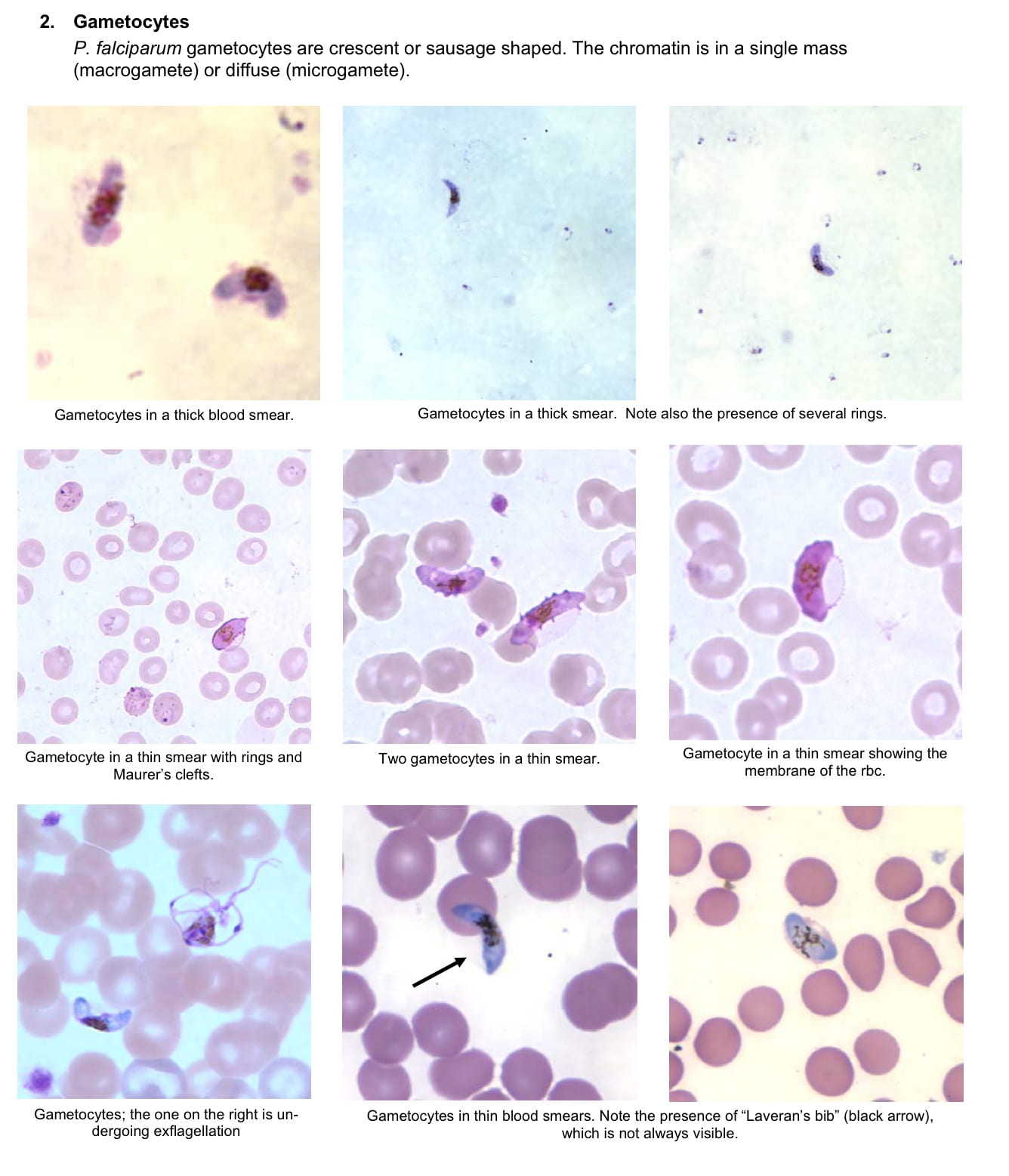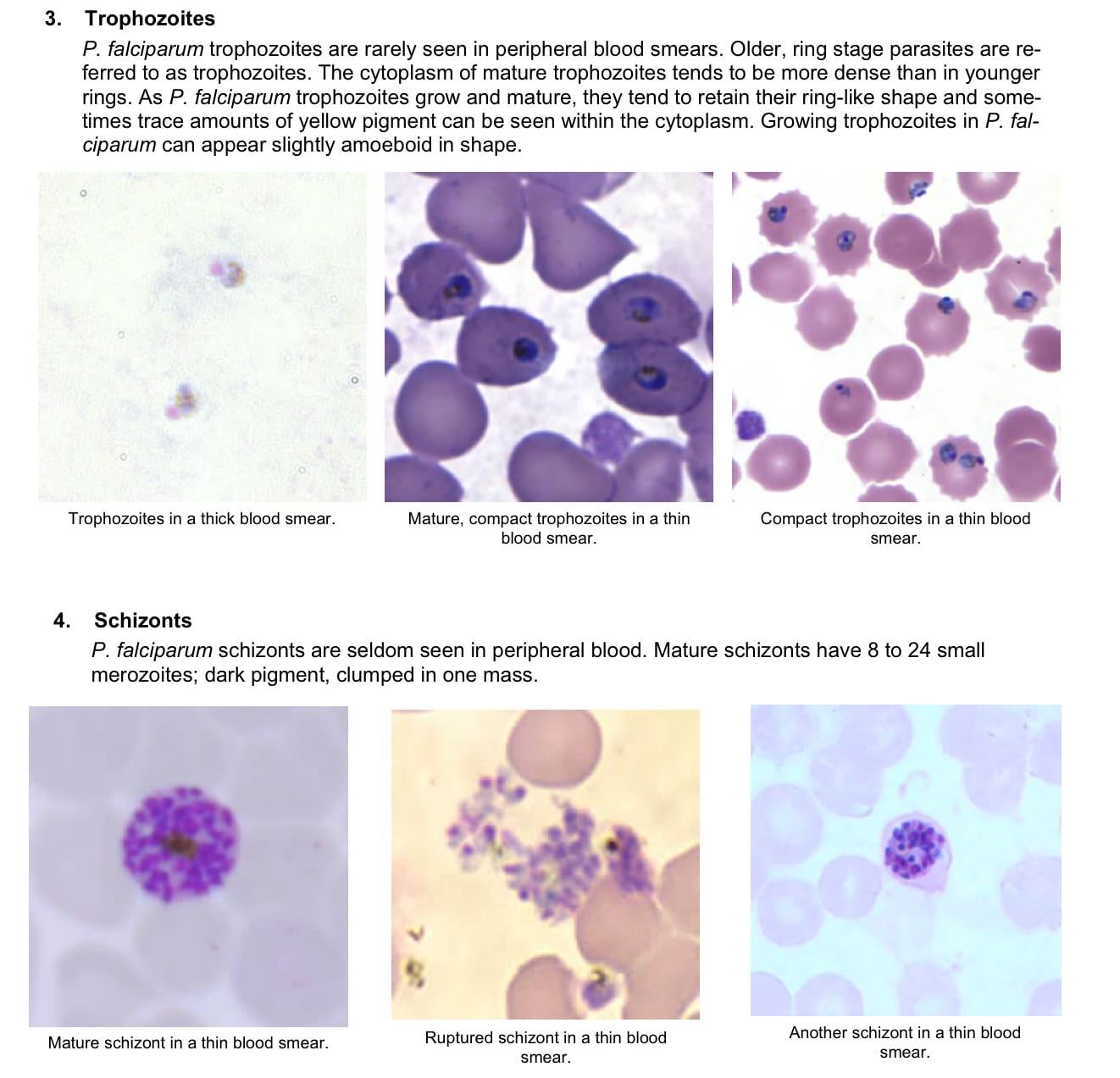The Life Cycle of Plasmodium Falciparum
The thing that makes an organism unique is its way of life. How it transforms and maneuvers throughout the world. A life cycle is a series of stages an organism passes through during over the span of its lifetime (The Evolution of Life Histories: Theory and Analysis, 1992). In the case of Plasmodium Falciform, there are many forms this parasite takes as well as have the ability to perform dual reproductive roles depending upon the host. The mosquito serves as the vector and the vertebrate serves as the needed host. Today we will journey through the malarial pathway and see exactly how these organisms operate.
The following images were obtained from the CDC official website and are visual representations of Plasmodium Falciparum. The ring form is a young trophozoite. During this stage, the merozoites begin to infect the red blood cells and will eventually mature into schizonts. The schizonts are the asexual immobile form of the parasite which is constantly dividing (Gaurab Karki, 2018). The gametocyte production plays a very important role. They are the infectious erythrocytic stage. There are two forms of gametocyte, a male and female form. The male form is known as the microgamete and the female form is the macrogamete (Gaurab Karki, 2018).
https://www.cdc.gov/dpdx/resources/pdf/benchAids/malaria/Pfalciparum_benchaidV2.pdf
 https://www.cdc.gov/dpdx/resources/pdf/benchAids/malaria/Pfalciparum_benchaidV2.pdf
https://www.cdc.gov/dpdx/resources/pdf/benchAids/malaria/Pfalciparum_benchaidV2.pdf
https://www.cdc.gov/dpdx/resources/pdf/benchAids/malaria/Pfalciparum_benchaidV2.pdf
This parasite exists in two different forms as well as take on different sizes according to this particular form. In the asexual form, the parasite is usually ring-shaped and in the sexual form they are much larger and are banana shaped (Plasmodium life cycle, 2008). The sexual phase of the occurs inside the mosquito and the asexual phase occurs inside the human host.
Let’s start with the culprit at hand, Anopheles. The sexual phase occurring in the mosquito known as sporogony. Here the parasite forms the infectious form that will be passed on to the human host. Anopheles draws blood from the host in which the male and female forms will enter the enteric area of the mosquito. The oocytes grow and divide many times until it becomes a sporozoite (Heather M Ferguson, 2004). Once the mosquito becomes full of sporozoites, they will travel to the salivary glands where it can now be injected into its human. Now we are inside the human where the asexual stage is known as schizogony. The sporozoites are festering inside the mosquito are injected into the human. We will begin with the pre-erythrocytic phase also known as Schizogony which occurs in the liver where they will form a schizont reaching around 60 micrometers in length (Tankeshwar,2012). This cycle occurs around 6 days. This stage is composed of small merozoites that enter the red blood cell and will begin the process of Erythrocytic Schizogony (Tankeshwar,2012). Now we are center stage in the red blood cell. This cycle consists of multiple parasites infecting single sets of red blood cells. The merozoites will get released from the liver, go through attachment and enter the RBC.
The incubation period is the cycle between the initial entry of the parasite from the bite and the first formation of symptoms. The time period is explicated below in the following chart and well as the other stages.
| Days | |
| Pro-erythrocytic phase | 5-7 |
| Erythrocytic cycle | 2 |
| Incubation period | 9-14 |
| Sporogony | 9-10 |
http://www.malwest.gr/enus/malaria/informationforhealthcareprofessionals/plasmodiumlifecycle.aspx

https://www.researchgate.net/profile/Zodwa_Dlamini/publication/259959318/figure/fig5/AS:202953156763657@1425399211263/Life-cycle-of-Plasmodium-falciparum-The-human-host-harbouring-sexually-immature-parasite.png
Plasmodium falciparum dietary need consists of the blood of the human. This is a heterotrophic organism. It has the ability to obtain its energy by consuming nutrients from another organism, which in this case would be the human host. They heavily rely on their host for survival and replication.

https://media.giphy.com/media/OV2NNybbYLCbm/giphy.gif
Check out this cool video of genetic engineering of malaria disease:
They were able to theorize what happened if you changed the genomic makeup of malaria in which would cause the mosquito to not be able to pass on malaria. They would also have to use a gene drive that would ultimately overpower the old genes and force the new gene to become dominant. Without this process included, the initial manipulated makeup would diminish as generations of mosquitos continued to be produced.


Tatiana Rodriguez April 23, 2019 - 2:01 am
Do you know what happens to the mosquito when many cysts are formed in the stomach wall? Does the mosquito die eventually?
The video at the end was very interesting. Altering the DNA of the mosquito to prevent malaria and other diseases sounds amazing. I believe that more studies are needed to fully understand the risks of doing such thing, but definitely it needs to be considered as an option to end one of the most disastrous disease. This way we could help developing countries and prevent many deaths.
bdavis72 May 2, 2019 - 3:47 am
Yes, the death toll for this disease is very disheartening and is something that I believe more people should be aware of. The cyst that are formed is actually causing more harm to the human than to the mosquito so it will not die in this transferral process. She will inject the cyst from the mouth canal and into her blood meal. The gene alteration was very interesting to learn about for me as well. I was unaware that such studies were transpiring.
akhademtabrizi1 May 2, 2019 - 2:38 am
it’s really interesting and scary that how sporozoite actually formed inside mosquito’s body and then she can bite you and transfer it into your bloodstream and cause to infected your liver cell and then sexual reproduction to produce Merozoite.
bdavis72 May 1, 2019 - 3:26 am
Yes, I agree! The adverse affects that the disease causes all beginning with an animal so small is also alarming. It is very hard to become aware that you are in the presence of a mosquito until it buzzing around in your ear in complete annoyance. Once it exits the liver cells and into the bloodstream towards the red blood cells that where the damage really starts becoming detrimental.